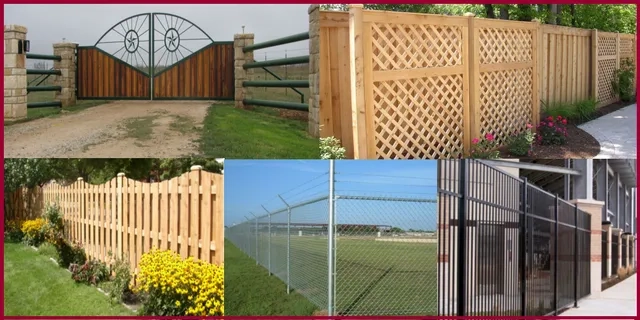When it comes to choosing a fence for your property, the material you select plays a huge role in its appearance, durability, and functionality. With so many options available, it can be overwhelming to decide which one is best for your needs. In this article, we’ll compare five popular fence materials—wood, vinyl, aluminum, chain-link, and composite—to help you make an informed decision.
1. Wood Fencing
Timber Fencing (Wood) is a classic and timeless choice for fencing, known for its natural beauty and versatility. It can be stained or painted to match your home’s exterior and is available in a variety of styles, such as picket, privacy, and split rail.
Pros:
- Aesthetic Appeal: Wood offers a warm, natural look that complements almost any property.
- Customizable: You can cut, stain, or paint wood to fit your design preferences.
- Eco-Friendly: Wood is a renewable resource, especially if sourced sustainably.
Cons:
- Maintenance: Wood requires regular upkeep, including staining or sealing, to prevent rot, warping, and insect damage.
- Durability: It’s susceptible to weathering and may need repairs or replacement over time.
- Cost: While affordable initially, long-term maintenance costs can add up.
Best For: Homeowners who prioritize aesthetics and don’t mind regular maintenance.
2. Vinyl Fencing
Vinyl fencing has gained popularity for its low maintenance and durability. It’s made from PVC and comes in a variety of styles and colors, mimicking the look of wood without the upkeep.
Pros:
- Low Maintenance: Vinyl doesn’t require painting or staining and is easy to clean with just soap and water.
- Durability: It’s resistant to rot, insects, and weathering, making it a long-lasting option.
- Variety: Available in many styles, including privacy, picket, and decorative designs.
Cons:
- Cost: Vinyl fencing can be more expensive upfront compared to wood or chain-link.
- Appearance: Some people find it less natural-looking than wood.
- Repairs: If damaged, vinyl sections may need to be replaced entirely.
Best For: Those looking for a low-maintenance, long-lasting fence with a clean, modern look.
3. Aluminum Fencing
Aluminum fencing is a lightweight yet durable option, often used for decorative purposes or to secure pools and gardens. It’s known for its elegant appearance and strength.
Pros:
- Durability: Aluminum is rust-resistant and can withstand harsh weather conditions.
- Low Maintenance: It doesn’t require painting or staining and is easy to clean.
- Aesthetic Appeal: Offers a sleek, ornamental look that enhances curb appeal.
Cons:
- Privacy: Aluminum fences are typically not solid, so they don’t provide much privacy.
- Cost: More expensive than chain-link but less than wrought iron.
- Strength: While durable, it’s not as strong as steel or wrought iron.
Best For: Homeowners seeking a decorative, low-maintenance fence for security or aesthetic purposes.
4. Chain-Link Fencing
Chain-link fencing is a practical and cost-effective option, commonly used for security, pet containment, and defining property boundaries.
Pros:
- Affordability: One of the most budget-friendly fencing options.
- Durability: Made from galvanized or coated steel, it’s strong and long-lasting.
- Low Maintenance: Requires minimal upkeep and is resistant to weathering.
Cons:
- Appearance: Lacks aesthetic appeal and doesn’t provide privacy unless privacy slats are added.
- Security: While functional, it’s not as secure as solid fencing options.
- Rust: Over time, untreated chain-link can rust, especially in humid climates.
Best For: Those needing a functional, budget-friendly fence for security or pet containment.
5. Composite Fencing
Composite fencing is a modern option made from a blend of wood fibers and recycled plastics. It combines the look of wood with the durability of synthetic materials.
Pros:
- Low Maintenance: Resistant to rot, insects, and weathering, requiring little upkeep.
- Aesthetic Appeal: Mimics the look of wood without the maintenance.
- Eco-Friendly: Often made from recycled materials, making it a sustainable choice.
Cons:
- Cost: More expensive than wood and vinyl upfront.
- Limited Styles: Fewer design options compared to wood or vinyl.
- Weight: Heavier than other materials, which can make installation more challenging.
Best For: Homeowners who want the look of wood without the maintenance and are willing to invest in a durable, eco-friendly option.
Which Fence Material is Right for You?
Choosing the right fence material depends on your priorities, whether it’s aesthetics, durability, maintenance, or cost. Here’s a quick summary to help you decide:
- Wood: Ideal for a natural, customizable look but requires regular maintenance.
- Vinyl: Perfect for low-maintenance, long-lasting fencing with a clean appearance.
- Aluminum: Great for decorative, rust-resistant fencing with minimal upkeep.
- Chain-Link: Best for budget-friendly, functional fencing.
- Composite: Excellent for eco-conscious homeowners who want durability and a wood-like appearance.
By understanding the pros and cons of each material, you can select the fence that best suits your property’s needs and your personal preferences. If you’re still unsure, consulting a professional fence contractor can provide valuable insights and help you make the right choice.
Investing in the right fence material not only enhances your property’s appearance but also ensures long-term satisfaction and functionality. Take your time to weigh your options, and you’ll find the perfect fence for your home or business!

